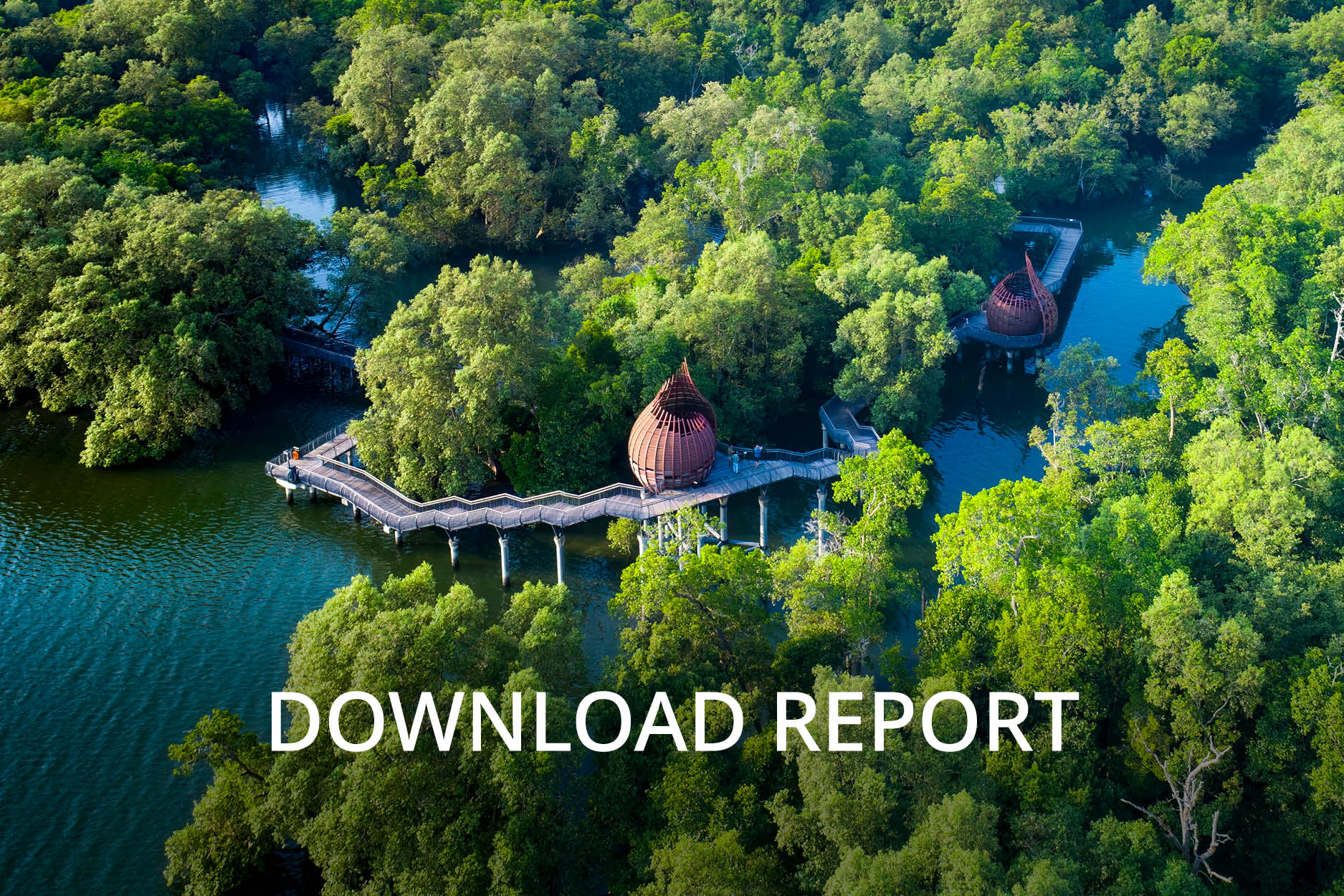Burning Questions: Harnessing Nature's Power for Climate Action
Burning Questions: Harnessing Nature's Power for Climate Action
In Brief:
Global warming is intensifying the frequency and severity of extreme weather events, endangering lives and impacting livelihoods
Nature-based Solutions (NbS), particularly forest conservation, sustainable forest management, and restoration, are crucial for mitigating climate change
NbS have the potential to deliver one-third of the emission reductions and removals necessary to put the world on track for net zero by 2050
Nature-based Solutions (NbS) harness the ability of the Earth's natural ecosystems to act as “carbon sinks”, removing carbon dioxide from the atmosphere while delivering a range of positive environmental, biodiversity, and social co-benefits.
Our planet faces a growing threat: rising temperatures and sea levels are disrupting our food and water security, and destabilising our supply chains. Left unchecked, these consequences will become irreversible.
To avoid breaching climate tipping points, the world must achieve net zero carbon emissions by 2050 – a goal central to the Paris Agreement, which aims to limit global warming to 1.5°C above pre-industrial levels. This ambitious target requires a dramatic reduction in global greenhouse gas emissions, which reached a record 57.1 GtCO2e in 2023, a 1.3% increase from 2022. Scientists tell us a 42% cut by 2030 is essential to safeguard our planet’s future.
Andrea Falleti, an Assistant Vice President in GenZero’s Investments team—a Temasek-owned investment platform dedicated to accelerating global decarbonisation—and Nigel Choo from Temasek’s Innovation team answer your burning questions on how Nature-based Solutions can play a crucial role in achieving this target.

What are Nature-based Solutions (NbS)?
Nigel: They’re exactly what their name suggests. If you think of our natural world – whether forests, wetlands, grasslands, marshes or even marine environments like kelp forests – these natural systems have been absorbing atmospheric carbon and regulating the Earth’s climate for millions of years. NbS encompasses a range of strategies to conserve, restore, and sustainably manage these natural and modified ecosystems.
Andrea: Trees are nature’s most established and effective carbon capture technology. But NbS extend far beyond forests. Peatland restoration, regenerative agriculture, and innovative approaches like alternating wet and dry rice cultivation, which is used in Asia to reduce methane emissions, are all examples of established NbS projects. Blue carbon projects, focused on conserving and restoring coastal ecosystems like mangroves and salt marshes, represent another vital category of NbS, leveraging the significant potential of these habitats to store – or sequester – carbon.
Why are NbS so important? And why now?
Andrea: NbS are critical now because we are at a tipping point in the climate crisis. The world is not on track to limit global warming to 1.5°C above pre-industrial levels, and the consequences of inaction are becoming increasingly dire. The increased frequency of extreme weather disasters all around us underscores the urgent need for action. NbS can get us back on course. They are readily available tools that are capable of delivering up to a third of the emission reductions and removals needed by 2030 to meet the Paris Agreement targets and keep global warming below critical thresholds. They are not just important, they are essential to getting us back on track.
Nigel: The important thing to remember is that it is not too late – but we must take action now. There is awareness and consensus that this is a crisis we need to address. We have the technologies, partnerships and capital to make a difference. At Temasek, for instance, we are working to reduce the net carbon emissions attributable to our portfolio to half of 2010’s levels by 2030, and to achieve net zero by 2050.
How do we know that NbS really make an impact? Can we measure it?
Nigel: We know that NbS have an impact because their carbon reductions or removals are quantified through a rigorous process called Measurement, Reporting, and Verification (MRV). It is only after this process is validated and completed that carbon credits, or standardised and tradable units of carbon that capture their impact, can be issued. These credits can be bought, sold, transferred or exchanged in carbon markets.
Andrea: Beyond carbon credits, NbS offer a wealth of additional benefits. Unlike some promising but nascent technologies, NbS are ready for implementation today. Most projects are cost-effective and the co-benefits are substantial, ranging from biodiversity improvements and habitat protection to positive impacts on the lives and livelihoods of local communities. This combination of near-term climate impact, cost-effectiveness, and positive co-benefits makes NbS a particularly compelling approach to addressing climate change.
Nature-based Solutions are critical now because we are at a tipping point in the climate crisis. They are capable of delivering up to a third of the emission reductions and removals needed by 2030 to meet the Paris Agreement targets and keep global warming below critical thresholds.
Andrea Falleti, Assistant Vice President, Investments, GenZero
How can carbon markets help us get to Net Zero faster?
Nigel: Carbon markets offer a mechanism to raise and channel capital towards climate action. By standardising carbon credits and making them tradable, these markets create a framework for global collaboration on climate mitigation. Independent registries and auditors certify that each credit represents a unit of carbon equivalent that has been avoided, reduced or removed from the atmosphere. Revenue from the sale of carbon credits is then channelled to climate-mitigation projects, supporting their development, implementation and long-term monitoring. This market-driven solution helps bridge the financing gap for climate mitigation projects, contributing to the transition to a net zero world.
Andrea: Improved Forest Management (IFM) projects are an example of how carbon markets can drive verifiable and additional climate action. Carbon finance, generated through the sale of carbon credits, provides the necessary resources to implement sustainable forestry practices, including reduced timber harvesting, which enhances carbon sequestration or conservation, allowing forests to grow older and reach their full carbon-storage potential.
Why not put all our resources into NbS then?
Andrea: NbS are a critical part of the solution, but they can’t do it all. At GenZero, we adopt a holistic investment approach that is focused on three key pillars to drive climate impact. The first pillar is focused on investing into NbS that help protect and restore natural ecosystems while benefiting local communities and biodiversity. The second pillar is focused on technology-based decarbonisation solutions for hard-to-abate sectors like aviation and the built environment. The third pillar is what we call carbon ecosystem enablers – we invest in companies or solutions that support the scaling of carbon markets to enable broader industry decarbonisation. GenZero’s three-pronged approach recognises the complexity of the climate challenge and the need for a range of complementary solutions.
Nigel: As investors, we look for businesses that are not only profitable but make a real impact. We explore different companies and solutions in the sustainability space, and invest across different areas to access a wider range of innovations and solutions. This approach is key for tackling different emission sources. We are in a unique position to be able to see a wide spectrum of technologies coming into this space. The onus is then on us to do our best to evaluate these companies, invest in or partner those with potential, and support them as they grow and scale their impact.
How can I play a part?
Andrea: The most powerful thing you can do is to stay informed. Go beyond the headlines and understand the challenges and opportunities in sustainability, engage in meaningful conversations, support projects that strive to make a difference, and advocate for policies that drive climate action. It is also important to remember that small changes in our personal lives can collectively make a big difference. By making conscious decisions in our daily routines, from how we travel to the products we buy, we can actively support the shift towards a more sustainable future.


